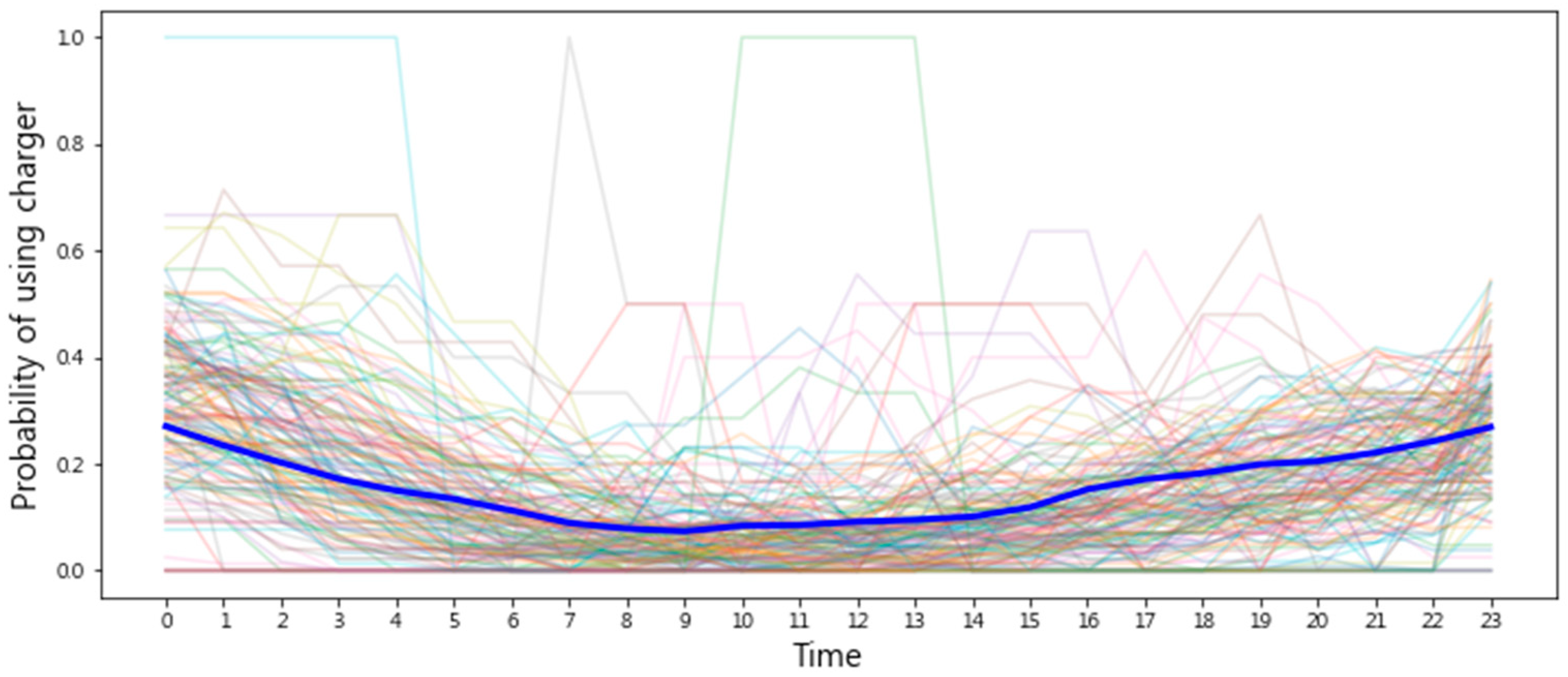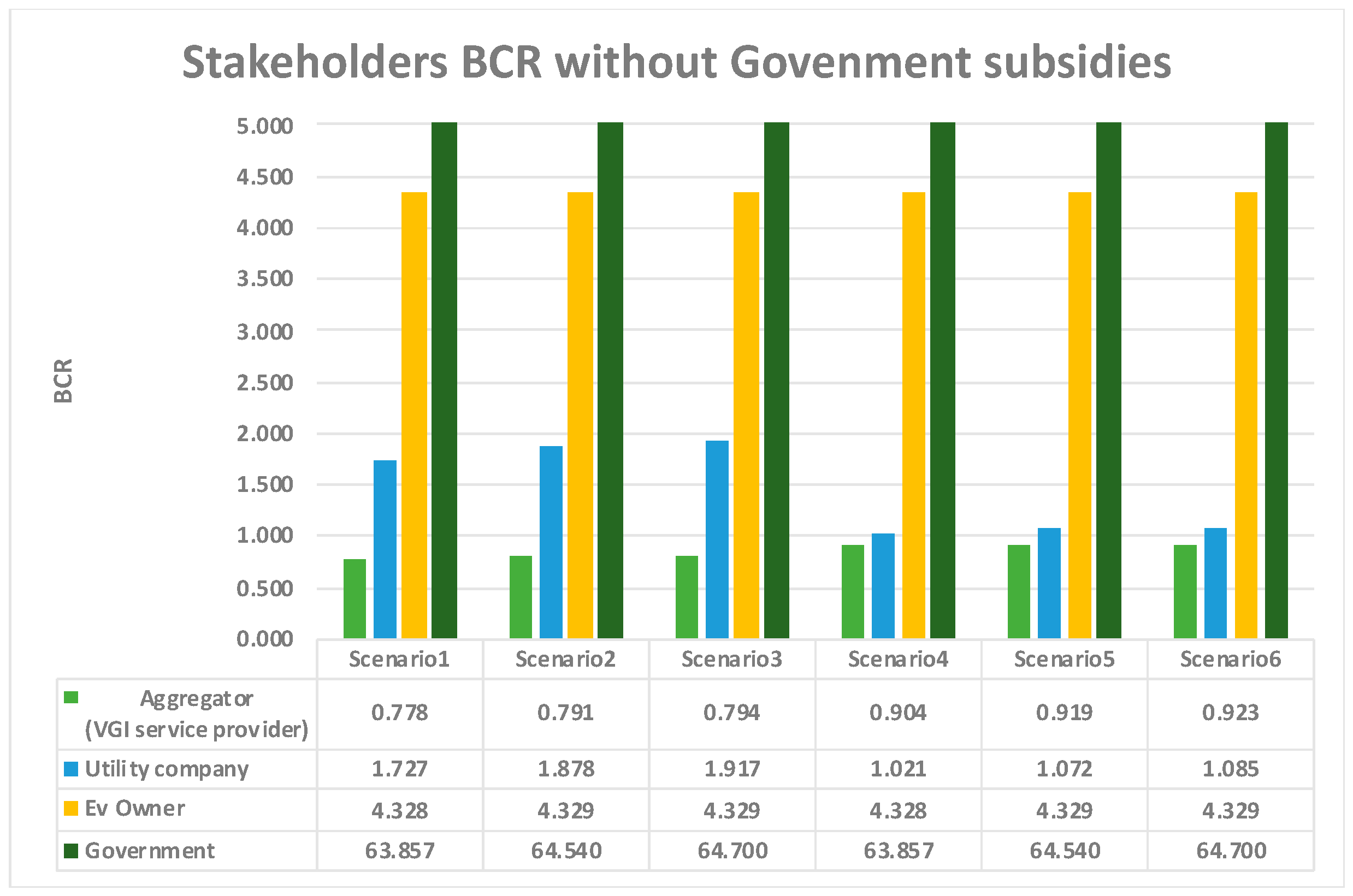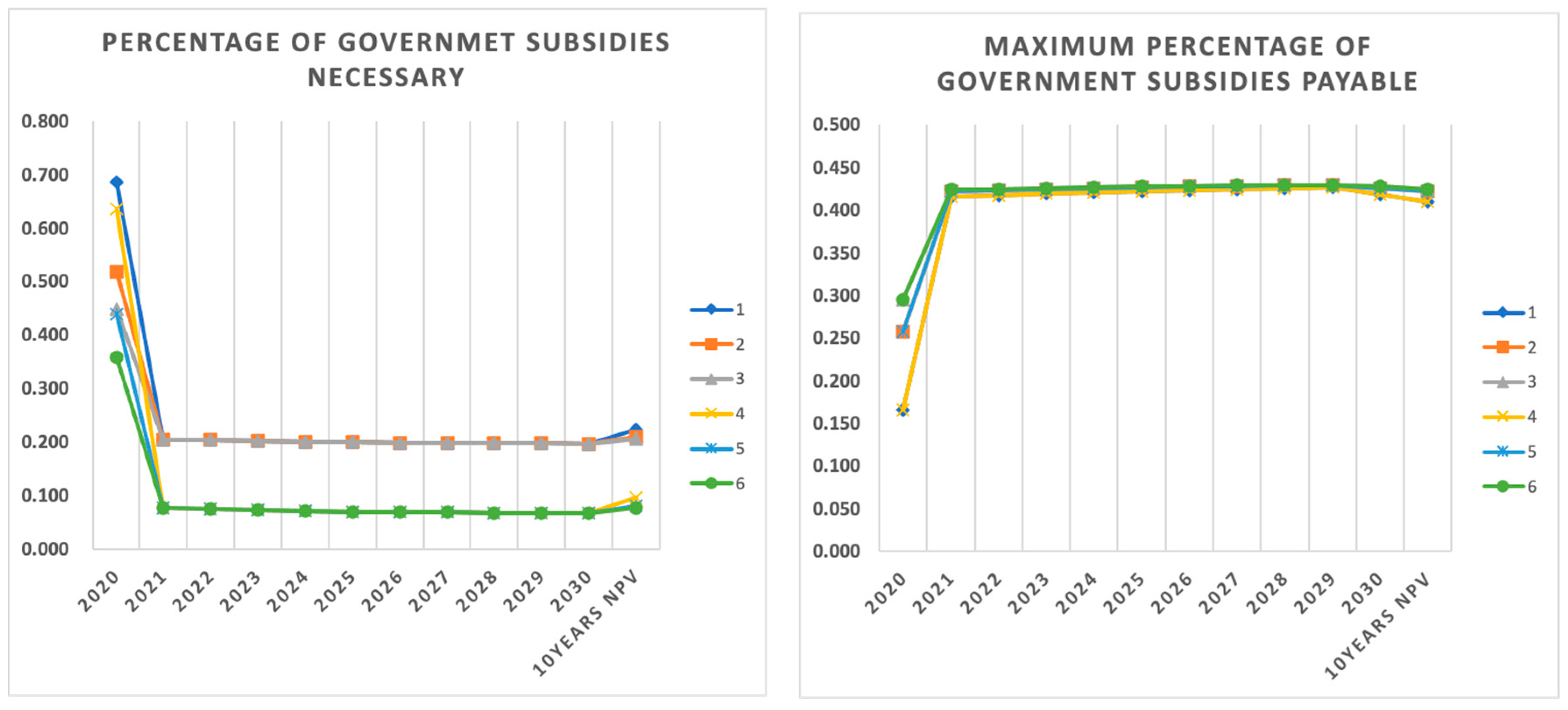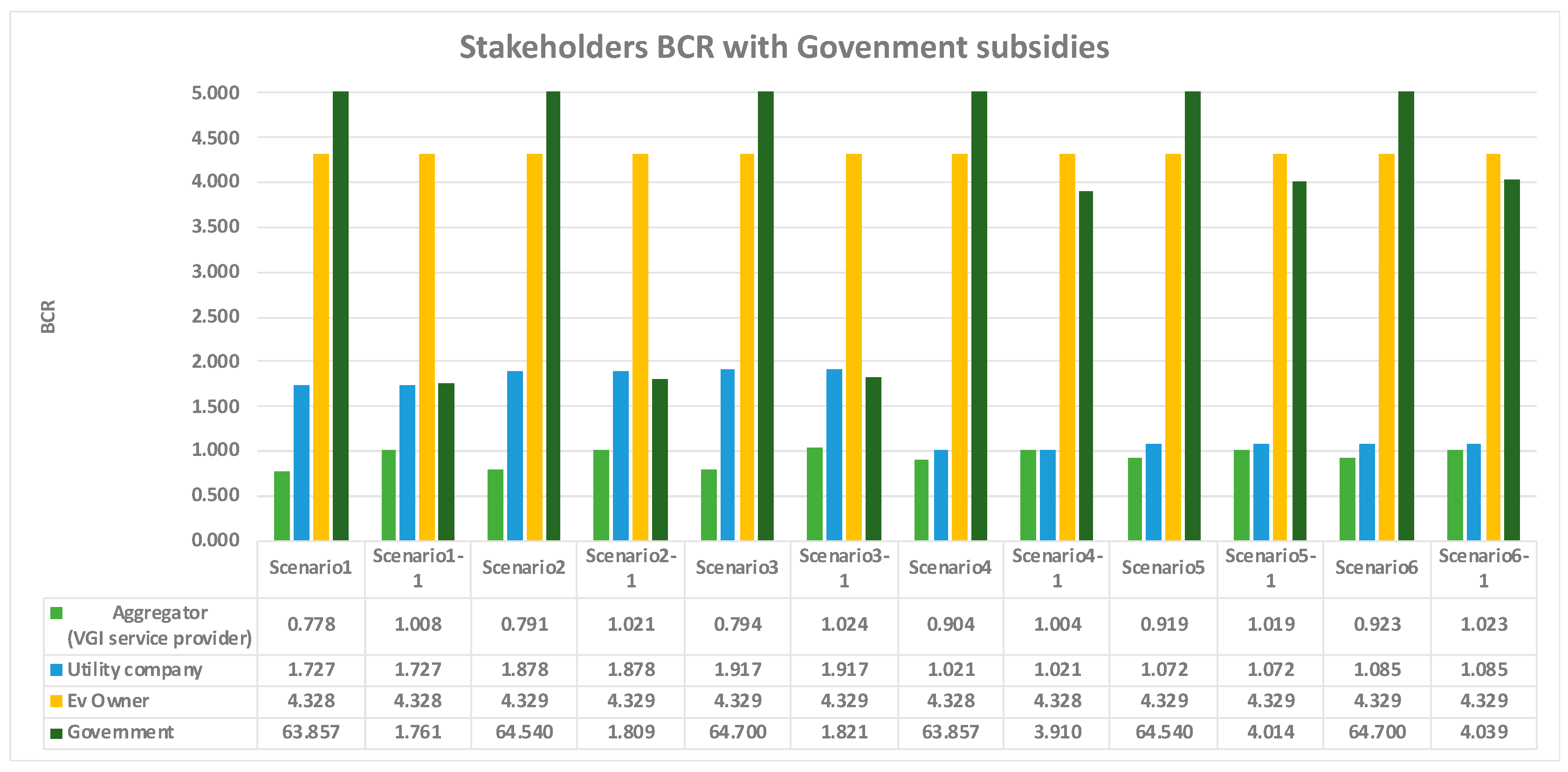Economic Valuation of Vehicle-Grid Integration (VGI) in a Demand Response Application from Each Stakeholder’s Perspective
Abstract
1. Introduction
2. Background and Literature Review
2.1. Demand Response Program in Korea
2.2. Economic Valuation Literature for VGI
3. Methodology
3.1. Estimated Available Capacity of VGI
3.2. Description of Stakeholders and Business Model
3.3. Factors of Benefit and Cost for Each Stakeholder
3.3.1. VGI Service Provider (Aggregator)
3.3.2. Utility Company
3.3.3. EV Owner
3.3.4. Government
3.4. Calculation of the Benefit-Cost Ratio
4. Results and Analysis
4.1. Scenarios
4.2. VGI without Subsidies
4.3. VGI with Government Subsidies
5. Conclusions and Implications
Author Contributions
Funding
Institutional Review Board Statement
Informed Consent Statement
Data Availability Statement
Conflicts of Interest
References
- Andersen, P.B.; Toghroljerdi, S.H.; Sørensen, T.M.; Christensen, B.E.; Høj, J.C.M.L.; Zecchino, A. The Parker Project; Final Report; DTU Library: Lyngby, Denmark, 2019. [Google Scholar]
- EPRI. Open Vehicle-Grid Integration Platform—Unified Approach to Grid/Vehicle Integration; EPRI: Washington, DC, USA, 2015. [Google Scholar]
- Kempton, W.; Tomić, J. Vehicle-to-grid power implementation: From stabilizing the grid to supporting large-scale renewable energy. J. Power Sources 2005, 144, 280–294. [Google Scholar] [CrossRef]
- Kempton, W.; Kubo, T. Electric-drive vehicles for peak power in Japan. Energy Policy 2000, 28, 9–18. [Google Scholar] [CrossRef]
- KPX. Power Market Operation Rules; KPX: Naju, Korea, 2020. [Google Scholar]
- Korea Power Exchange Electricity Market Trading System DR. Available online: https://dr.kmos.kr/nx/nxIndex.do (accessed on 1 October 2020).
- Steward, D.M. Critical Elements of Vehicle-to-Grid (V2G) Economics; NREL: Golden, CO, USA, 2017.
- De Los Ríos, A.; Goentzel, J.; Nordstrom, K.E.; Siegert, C.W. Siegert Economic analysis of vehicle-to-grid (V2G)-enabled fleets participating in the regulation service market. In Proceedings of the 2012 IEEE PES Innovative Smart Grid Technologies (ISGT) 2012, Washington, DC, USA, 16–20 January 2012; pp. 1–8. [Google Scholar]
- Zeng, W.; Gibeau, J.; Chow, M. Economic benefits of plug-in electric vehicles using V2G for grid performance-based regulation service. In Proceedings of the IECON 2015-41st Annual Conference of the IEEE Industrial Electronics Society, Yokohama, Japan, 9–12 November 2015. [Google Scholar]
- Kamboj, S.; Kempton, W.; Decker, K.S. Deploying power grid-integrated electric vehicles as a multi-agent system. In Proceedings of the 10th International Conference on Autonomous Agents and Multiagent Systems, Taiwan, China, 2–6 May 2011; pp. 13–20. [Google Scholar]
- Kempton, W.; Tomić, J. Vehicle-to-grid power fundamentals: Calculating capacity and net revenue. J. Power Sources 2005, 144, 268–279. [Google Scholar] [CrossRef]
- Noel, L.; McCormack, R. A cost benefit analysis of a V2G-capable electric school bus compared to a traditional diesel school bus. Appl. Energy 2014, 126, 246–255. [Google Scholar] [CrossRef]
- Brandt, T.; Wagner, S.; Neumann, D. Evaluating a business model for vehicle-grid integration: Evidence from Germany. Transp. Res. Part D Transp. Environ. 2017, 50, 488–504. [Google Scholar] [CrossRef]
- Abdelwahab, O.M.; Shaaban, M.F. PV and EV charger allocation with V2G capabilities. In Proceedings of the 2019 IEEE 13th International Conference on Compatibility, Power Electronics and Power Engineering (CPE-POWERENG) 2019, V2G capabilities, Sonderborg, Denmark, 23–25 April 2019; pp. 1–5. [Google Scholar]
- Madlener, R.; Kirmas, A. Economic Viability of Second Use Electric Vehicle Batteries for Energy Storage in Residential Applications. Energy Procedia 2017, 105, 3806–3815. [Google Scholar] [CrossRef]
- Raoofat, M.; Saad, M.; Lefebvre, S.; Asber, D.; Mehrjedri, H.; Lenoir, L. Wind power smoothing using demand response of electric vehicles. Int. J. Electr. Power Energy Syst. 2018, 99, 164–174. [Google Scholar] [CrossRef]
- Mullan, J.; Harries, D.; Bräunl, T.; Whitely, S. The technical, economic and commercial viability of the vehicle-to-grid concept. Energy Policy 2012, 48, 394–406. [Google Scholar] [CrossRef]
- Oliver Warweg Achievable Revenues for Electric Vehicles According to Current and Future Energy Market Conditions; IEEE: New York, NY, USA, 2016.
- Agarwal, L.; Peng, W.; Goel, L. Using EV battery packs for vehicle-to-grid applications: An economic analysis. In Proceedings of the 2014 IEEE Innovative Smart Grid Technologies-Asia (ISGT ASIA), Kuala Lumpur, Malaysia, 20–23 May 2014; pp. 663–668. [Google Scholar]
- Li, X.; Tan, Y.; Liu, X.; Liao, Q.; Sun, B.; Cao, G.; Li, C.; Yang, X.; Wang, Z. A cost-benefit analysis of V2G electric vehicles supporting peak shaving in Shanghai. Electr. Power Syst. Res. 2020, 179, 106058. [Google Scholar] [CrossRef]
- Will, C.; Schuller, A. Understanding user acceptance factors of electric vehicle smart charging. Transp. Res. Part C Emerg. Technol. 2016, 71, 198–214. [Google Scholar] [CrossRef]
- Power Data Open Portal System. Available online: https://bigdata.kepco.co.kr/cmsmain.do?scode=S01&pcode=main&redirect=Y (accessed on 1 November 2019).
- Korean Government. Future Automotive Industry Development Strategy (National Roadmap for 2030); Korean Government: Seoul, Korea, 2019.
- KPX. Korea Power Exchange Market Statistics for 2019; KPX: Naju, Korea, 2020. [Google Scholar]
- KEPCO Electricity Tariff. Available online: Cyber.kepco.co.kr (accessed on 1 September 2019).
- KERI. Demand Management Project Evaluation Report; KEPCO: Naju, Korea, 2012. [Google Scholar]
- KEPCO. EV-Grid Integration(VGI) and control technology development and wide area V2G field demonstration for EV as a fast-DR resource). Unpublished work, in progress.
- KPX. Power Generation Facility Status in 2018; KPX: Naju, Korea, 2018. [Google Scholar]






| Year | 2020 | 2021 | 2022 | 2023 | 2024 | 2025 | 2026 | 2027 | 2028 | 2029 | 2030 |
|---|---|---|---|---|---|---|---|---|---|---|---|
| # EVs | 197 | 313 | 466 | 656 | 881 | 1143 | 1442 | 1777 | 2148 | 2556 | 3000 |
| # Chargers (q) | 32 | 51 | 77 | 108 | 145 | 188 | 237 | 292 | 353 | 420 | 493 |
| Capacity (MW) | 1.77 | 2.82 | 4.19 | 5.90 | 7.93 | 10.29 | 12.97 | 15.99 | 19.33 | 23.00 | 26.99 |
| Stakeholders | Code | Factors | Description | |
|---|---|---|---|---|
| Service provider | B | SB1 | Settlement for Type I DR | 60 h/year, fixed + performance based (SMP) |
| SB2 | Settlement for Type II DR | 5-year average, 1670 h/year, payment based on SMP | ||
| SB3 | Utility subsidy | Compensation for DSM and reserve | ||
| SB4 | Government subsidy | Subsidy for capital expenditure (CAPEX) and operating expenditure (OPEX) | ||
| C | SC1 | Payment for EV owners | 90% of (SB1 + SB2 + SB3) | |
| SC2 | VGI operating system | EMS investment for V1G/V2G | ||
| SC3 | Chargers installation | In proportion to consumer participation and access | ||
| SC4 | Operation/management | 15% of (SC2 + SC3) | ||
| SC5 | Recharging | Cost of recharging to the initial SOC | ||
| Utility | B | KB1 | DSM cost reduction | Benefits due to increased reserve |
| KB2 | Blackout compensation | The expected reduction in blackout time | ||
| KB3 | Government subsidy | Subsidy for CAPEX and OPEX | ||
| C | KC1 | T&D investment | Cost for T&D investment for V2G | |
| KC2 | Subsidy for service providers | 50% of KB1 allocated for subsidy | ||
| KC3 | VGI operating systems | EMS investment for V1G/V2G | ||
| EV owner | B | EB1 | Reward for VGI participation | (=SC1) payment from service provider |
| EB2 | Government subsidy | For investment in OBC and EV for VGI participation | ||
| C | EC1 | Battery degradation | 30 KRW/kWh | |
| EC2 | VCMS | PLC communication and control | ||
| EC3 | Bidirectional OBC | AC charge/discharge | ||
| Government | B | GB1 | Grid investment deferral | Investment deferral on generation, T&D facilities |
| GB2 | Blackout compensation | (=KB2) the expected reduction in outage time | ||
| GB3 | DSM cost reduction | (=KB1) due to increased reserve capacity | ||
| GB4 | CO2 emission reduction | CO2 emission reduction due to fossil fuel reduction | ||
| GB5 | Value-added creation | Economic-value-added creation | ||
| GB6 | Production inducement | Production inducement in adjacent industries | ||
| C | GC1 | Subsidy | Commensurate with other stakeholders BCR | |
| Year | 2020 | 2021 | 2022 | 2023 | 2024 | 2025 | 2026 | 2027 | 2028 | 2029 | 2030 |
|---|---|---|---|---|---|---|---|---|---|---|---|
| VGI chargers | 259 | 412 | 613 | 862 | 1158 | 1503 | 1895 | 2335 | 2824 | 3359 | 3943 |
| Parameter | Value |
|---|---|
| Average electricity rate (EB) | 109 KRW/kWh |
| Compensation multiplier (M) | 3 |
| Power outage time (t) | 0.1922 h per household |
| The number of households (n) | 23,501,542 |
| Total generation capacity (TC) | 125,338 MW |
| Scenario | Government Subsidies | Utility Company Policy | Plug-in Rate | Scenario | Government Subsidies | Utility Company Policy | Plug-in Rate |
|---|---|---|---|---|---|---|---|
| 1 | 0 | KB1 0.5 | 0.08 | 1–1 | 0.23 | KB1 0.5 | 0.08 |
| 2 | 0 | KB1 0.5 | 0.2 | 2–1 | 0.23 | KB1 0.5 | 0.1 |
| 3 | 0 | KB1 0.5 | 0.3 | 3–1 | 0.23 | KB1 0.5 | 0.15 |
| 4 | 0 | KB1 0.9 | 0.08 | 4–1 | 0.1 | KB1 0.9 | 0.2 |
| 5 | 0 | KB1 0.9 | 0.2 | 5–1 | 0.1 | KB1 0.9 | 0.08 |
| 6 | 0 | KB1 0.9 | 0.3 | 6–1 | 0.1 | KB1 0.9 | 0.1 |
Publisher’s Note: MDPI stays neutral with regard to jurisdictional claims in published maps and institutional affiliations. |
© 2021 by the authors. Licensee MDPI, Basel, Switzerland. This article is an open access article distributed under the terms and conditions of the Creative Commons Attribution (CC BY) license (http://creativecommons.org/licenses/by/4.0/).
Share and Cite
Moon, Y.; Ahn, J.; Hur, W.; Kim, W.; Shin, K. Economic Valuation of Vehicle-Grid Integration (VGI) in a Demand Response Application from Each Stakeholder’s Perspective. Energies 2021, 14, 761. https://doi.org/10.3390/en14030761
Moon Y, Ahn J, Hur W, Kim W, Shin K. Economic Valuation of Vehicle-Grid Integration (VGI) in a Demand Response Application from Each Stakeholder’s Perspective. Energies. 2021; 14(3):761. https://doi.org/10.3390/en14030761
Chicago/Turabian StyleMoon, Yongma, Joongseok Ahn, Wonchang Hur, Wooje Kim, and Kwangsup Shin. 2021. "Economic Valuation of Vehicle-Grid Integration (VGI) in a Demand Response Application from Each Stakeholder’s Perspective" Energies 14, no. 3: 761. https://doi.org/10.3390/en14030761
APA StyleMoon, Y., Ahn, J., Hur, W., Kim, W., & Shin, K. (2021). Economic Valuation of Vehicle-Grid Integration (VGI) in a Demand Response Application from Each Stakeholder’s Perspective. Energies, 14(3), 761. https://doi.org/10.3390/en14030761









